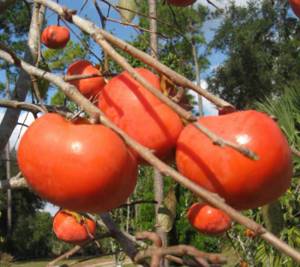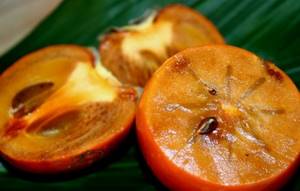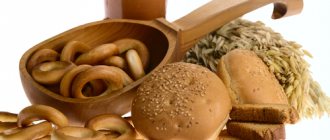How to let persimmons ripen at home?
Persimmon or “food of the gods” - this is how its name is translated from Latin, is an atypical fruit for our latitudes. This means that they are often delivered unripe, so that during transportation the fruits do not become crushed or spoiled. Unripe persimmons have an unpleasant, strongly astringent taste. There is almost no sweetness in it. In addition, eating green fruits can cause stomach upset and intestinal problems. Fortunately, you can easily make persimmons ripen at home.
Despite the presence of sugars in the pulp and juice of the fruit, it is impossible to gain weight from persimmon. Its calorie content is extremely low - only 60 kcal per 100 grams. In addition, the fruit is easily digestible and contains a lot of vitamins.
How to choose a persimmon so as not to wonder “why the persimmon knits again”
Persimmon is a winter berry that pleases the eye with its bright color, but can disappoint with its astringent taste. Therefore, it is important to know why persimmons are astringent in order to choose the ideal fruit - tasty, juicy and aromatic. This is not difficult to do if you know some nuances.
Persimmon is a sweet winter berry. It has an extraordinary taste and sunny color, which simply attracts you during the cold season, which is so poor in warmth and color. However, the winter peach is not so simple; it can attract with its appearance, but repel with its astringent taste. Therefore, it is very important to learn how to choose persimmons in order to get the desired result - both beauty and pleasant taste.
How to choose the right persimmon. Why persimmon knits
Persimmon can be divided into two types: regular and kinglet. The first one knits until it is completely ripe, then the inside becomes jelly-like. Wren almost never has an astringent taste; this variety of persimmon has a sweet and delicate taste even when unripe.
To find the ideal fruit, you need to know how to determine the ripeness of a common persimmon by appearance:
- The persimmon peel is slightly lighter than deep red, bright, smooth and shiny. Dark spots indicate that the fruit is spoiled or already overripe.
- The stalks and leaves are dry, dark brown.
- The fruit is soft and shiny.
These characteristics apply to a simple fruit, but the kinglet must be looked for by other characteristics. If you are at a loss as to how to choose a king persimmon, you should know that when it is pollinated, seeds are formed, thanks to which the fruit will be sweet-tasting and strong, with a brown tint inside. If pollination does not occur, then there will be no seeds - the berry will be astringent and tart. Although persimmon does not lose its nutritional properties. However, such fruits will never become soft and tasty.
How to choose the right kinglet:
- The ideal fruit is small and round.
- The skin is brown, fragrant or reddish-dark.
- The pulp has dark veins.
- The barrels are dense and hard.
As mentioned above, wren is a type of persimmon that has an excellent taste. However, it happens that the wren also knits. There is only one reason - these are not pollinated berries, which are not only tart, but also hard.
Why persimmon knits
Persimmon fruits contain large amounts of tannin - a tannin with an astringent taste. But usually only after eating an unripe persimmon does the mouth feel astringent, because it is impossible to feel the tannin in ripe fruits. By the way, there is no such substance in the king at all, which is why the ripe fruit never has an astringent taste.
However, persimmon simply needs an astringent taste. Thanks to him, it protects the bark and leaves from harmful microorganisms and being eaten by animals. And it won’t harm a person, so if persimmons make your mouth stick, you shouldn’t immediately stop eating them - tannic acid has a good effect on the nervous and digestive systems. Those who suffer from abdominal ailments and those who have undergone operations on the gastrointestinal tract should be wary.
How to prevent persimmon from gagging your mouth.
Here, you can learn in detail about how to get rid of the astringency of persimmons using one of the methods below.
The most common ways to get rid of the astringency of persimmons:
- Place apples or tomatoes tightly in a plastic bag, and persimmons between them. They will release ethylene gas. This will help winter berries ripen faster;
- Pour water at room temperature or a couple of degrees higher into a container and put the persimmons there for 12 hours. The tannins will go away, and with them the unpleasant taste.;
- Place the berries in the freezer for a couple of hours. Then defrost on a plate, leaving it in the room for half an hour;
- Dry or wilt the berries. A cloying taste will appear;
- Prick in several places with a needle, which is moistened with alcohol;
- Use a knife to make cuts in four places of the fruit and pour hot water, then the viscosity will disappear.
How to choose a persimmon that does not knit
The surest way to buy a pleasant-tasting persimmon is to buy a pollinated wren. This variety is impeccable! You can also focus on the external signs of an ordinary fruit: bright orange color, transparent skin, slightly dark, with black strokes. Thanks to this express method for determining tannin in persimmons, you will be able to find the ideal fruit!
So, if you are suffering because the fruit and vegetable season is very far away, don’t be sad. During the persimmon season, you will receive not only a tasty and aromatic fruit, but also the joy of taste and color. The main thing is to learn how to choose it correctly and know a few rules for its correct use, then you won’t have to wonder why persimmons are knitting: there will always be a sunny fruit with a great taste on your table!
How to let it ripen?
Use the following tricks:
- To ripen, persimmons need ethylene. It is produced in abundance by already ripe fruits. Therefore, in order for the fruit to ripen, place it in the same container with already ripe apples. The riper they are, the faster the result. You can also take other fruits.
- Place in the freezer for a day, then remove and defrost at room temperature. Persimmons treated at low temperatures become soft and sweet. True, depending on the variety, it can soften so much that it becomes like puree.
- Leave the persimmon in warm water for a day. The temperature should not be higher than 40 degrees, otherwise the skin will “cook”.
- Moisten the needle in ethyl alcohol and pierce the fruit from different sides. Leave at room temperature - ripening will go faster.
- Well, the most natural way is to simply leave the fruits on the table for a couple of days, waiting for them to ripen.
Ripe persimmon tastes very good. There are regular and chocolate varieties. Each of them is healthy and tasty in its own way. To get the maximum benefit from this fruit, it is better to use method 1 or 5 for ripening. With them, the process occurs naturally, which means that all vitamins are preserved unchanged.
How to make persimmon jam?
Jam is made only from ripe persimmons. There are many ways to make persimmon jam:
- With vanilla
- Star anise
- Carnation
- Citrus zest and pulp
Persimmon and tangerine jam: recipe
For jam we take:
- 800 g each of tangerines, persimmons and sugar
Cooking:
- We peel the tangerines and separate them into slices.
- We peel the washed persimmons and cut them into cubes.
- Mix tangerine slices and persimmon cubes, sprinkle with sugar, and put on low heat to simmer for half an hour, then remove from heat and cool completely.
- The next day, cook the jam again, but for 10 minutes, over low heat, pour into jars and seal.
Persimmon jam
How to choose a good fruit?
How to choose this exotic fruit correctly so that you don’t have to do tricky manipulations to speed up its ripening?
When purchasing, pay attention to the following points:
- Be sure to take the fruit in your hands and evaluate how soft it is. If the persimmon is hard, this is a sure sign that it is still green.
- The presence of black stripes on the skin means that the fruit is already completely ripe and can be eaten. If you notice such a sign, you can safely make a purchase.
- Black dots. Not such a rosy signal. They say that the fruits were collected very early, completely green, and they ripened during transportation or in special chambers. There will be fewer vitamins in such persimmons.
- Pedicel. If it is dry, this is a sign that this is a ripe fruit.
Make the right purchases and choose only ripe produce. Then you won't have to waste time waiting for it to ripen. You can immediately enjoy the pleasant tart taste.
- Be sure to take the fruit in your hands and evaluate how soft it is. If the persimmon is hard, this is a sure sign that it is still green.
- The presence of black stripes on the skin means that the fruit is already completely ripe and can be eaten. If you notice such a sign, you can safely make a purchase.
- Black dots. Not such a rosy signal. They say that the fruits were collected very early, completely green, and they ripened during transportation or in special chambers. There will be fewer vitamins in such persimmons.
- Pedicel. If it is dry, this is a sign that this is a ripe fruit.
How to choose persimmon
In order to fully convey the beneficial properties of persimmon for the body, it would be nice to know how to buy it correctly.
It is worth knowing that persimmon fruits with seeds (like the “Korolek” variety), even when not ripe, are not as strongly astringent as seedless varieties. It is worth paying attention to the leaves of the persimmon: light green ones indicate that it is not ripe, so preference should be given to fruits with dried foliage.
Small brown spots should not be scary - this is a sign of ripeness, but large spots that are soft to the touch are a sign of spoilage of the persimmon.
Persimmon fruits are often sold on the street. She is not afraid of frost, this is not a reason to pass by the treasured delicacy, but it is worth paying attention to the point of sale that is located away from the road, and that the seller is neat and keeps the workplace in an appropriate condition.
Well, if it turns out that the purchase turned out to be unripe, it doesn’t matter, it’s fixable.
How to store persimmons
The beneficial properties of this fruit have been known to mankind for many hundreds of years. Its beneficial effect on the functioning of the liver and kidneys has led to the continued use of such fruits as a medicine for a number of diseases. At the same time, this fruit has a number of disadvantages - in particular, it spoils very quickly if storage conditions are not met. Accordingly, to ensure the maximum shelf life of these fruits for food, you need to know how to properly store persimmons at home.
How to properly store persimmons
It is worth noting that storage requirements vary somewhat depending on the degree of ripeness of the fruit. In particular, the requirements for storing unripe persimmons will differ significantly from the conditions for storing ripe fruits.
Interesting: Shelf life of cutlets in the freezer
When purchasing ripe fruits, it is necessary to store persimmons at home in such a way as to prevent them from spoiling due to rotting.
The choice of where to do this will depend on the desired shelf life of the fruit, as well as personal wishes regarding their condition after storage.
For example, you can store persimmons at home in the refrigerator at a temperature of 0 to -1 degrees. In this case, the period of fruit suitability will last for approximately 3-4 months. The main condition for storing persimmons at home in winter in such conditions is to maintain the humidity level in the range from 80% to 90%. If the humidity level drops below the specified level, the fruits will begin to dry out and shrink. With higher humidity, they may begin to become moldy.
It is also correct to store persimmons in the freezer. When using the fast freezing mode, the original aroma of these fruits can be preserved, and if the temperature is maintained at a sufficiently low level throughout the storage period, the shelf life of the fruit can be up to six months. The only drawback of this option is the mushy state of the fruit pulp after defrosting.
Considering the ripening time of these fruits, you should not store persimmons outside the refrigerator in winter, since unstable temperature and humidity levels will not ensure long-term preservation of stocks.
Persimmon or kinglet: how to choose the right healthy miracle fruit
YEREVAN, November 25. News-Armenia
. With the arrival of November, fresh persimmons appear on market shelves - a real autumn fruit, both in color and in season. It can be both tart and astringent and sweet - and depending on the variety, it requires different handling. Persimmon is very useful. It compensates for the lack of vitamins and microelements in the body - primarily vitamins C, P, beta-carotene, group B, iodine, potassium, magnesium. It delicately stimulates the digestion process due to dietary fiber, which it contains in large quantities. In addition, dietary fiber slows down the absorption of sugars and lowers cholesterol levels, and absorbs harmful impurities, including salts of heavy metals.
In the end, 100 grams of persimmon contain approximately 70 kcal, however, after eating a piece or two, you will feel full for a long time, writes otyrar.kz.
There are about two thousand varieties of persimmon in the world. It can be from red to dark brown, from perfectly round and heart-shaped to flattened and almost square. And it also weighs differently - from 60 to 500 grams.
In the minds of ordinary buyers, all persimmons are divided into two types: astringent and non-astringent. Astringent varieties are edible only when they are fully ripe - in the case of some varieties, almost to a jelly-like state.
How to cook
Most often, persimmons are eaten fresh. However, it makes excellent salads and snacks, desserts and baked goods, cocktails and other drinks. You can cook very interesting meat dishes with persimmons.
Dried persimmon is very popular in the East. In Japan it is called hoshigaki, in China - shi-bing, in Korea - gotgam, in Vietnam - hong ho. Dried persimmons are eaten as a snack, dessert, and used to prepare various dishes (in much the same way as other dried fruits). In Korea, dried persimmon fruits are used to make the traditional Korean spice sujeonggwa, and the ripened fermented fruits are used to make gamsikcho persimmon vinegar.
In some areas of Manchuria and Korea, dried persimmon leaves are used to make tea. Its Korean name is ghamnip cha.
Season
Persimmon season begins at the end of October and continues until December. The last of the seasonal persimmons can be purchased in early January. During these months, persimmons are mainly supplied to Russia from Uzbekistan and Azerbaijan.
How to select and store
The first impression of persimmons can be deceiving: attractive-looking fruits may turn out to be sweet, but completely inedible. The fact is that while persimmon fruits ripen, they contain tannins - they provide a specific “astringent” effect. Only fully ripe persimmons can be guaranteed sweet, tender, and non-astringent. But how to recognize ripe and unripe fruits?
All varieties of persimmon are divided into two types - “regular”, or persimmon itself, and “kings”. Ordinary persimmon loses its astringent taste only after full ripening, when its pulp acquires a jelly-like consistency.
The news is loading... “Right” The wren does not knit in principle: it is always sweet and tender, even if it is a little unripe. However, there is one “but”. If pollination has occurred and seeds have formed, the “wren” ripens strong, sweet and tasty, brown inside (for this it is also called “chocolate”). If there was no pollination, seeds are not formed, and instead of a chocolate “king” you get tart, astringent fruits. Quite nutritious, but rather tasteless. Moreover, their taste no longer depends on the period of ripening: early-ripening, mid-ripening, and late-ripening varieties can be tart.
Try to choose a king with soft barrels. The main thing is to look at the stalk: both the leaves and the stalk itself should be dry and brown in color.
The kinglet can be identified by its characteristic dark red skin and brown flesh with even darker veins. As a rule, these are small round fruits.
Persimmon of the “Shakhinya” variety has an amazing taste - bright, large, heart-shaped. But this is not a “wren”, which means that if the fruits are not ripe, they may have an astringent taste. Ripe “shakhinya” can be distinguished by its translucent skin with thin black rings: the more of them, the more ripe the persimmon.
Ripe persimmons should be soft, with smooth, shiny, thin translucent skin.
The astringent taste is not characteristic of Spanish persimmons - large, bright orange, dense and sweet. The Israeli Sharon persimmon variety also contains very little tannin.
Here are some ways to help persimmons ripen
.
1. Place it in the same plastic bag with apples or tomatoes: these fruits emit ethylene gas, which will make the persimmon ripen faster.
2. Keep the persimmon in warm (30-40 degrees) water for 10-12 hours - the tannins, and therefore the astringent taste, will go away.
3. Prick hard fruits with a needle dipped in alcohol.
4. Astringent persimmons can be frozen, wilted or dried. Dried persimmon is absolutely not astringent, however, if it is wet, the tart, unpleasant taste can be restored.
Loading news... "Levo"
Freshly purchased persimmons can be stored in the refrigerator along with other products, but if stored in this way, the fruits should be consumed within three days.
A lower temperature, from 0 to -1 degrees, will help prolong the freshness of persimmons: this way the fruit will last for about three months. The humidity should be 85-90%: if the humidity level is lower, the persimmon will begin to wrinkle, and with higher humidity, the fruits will become moldy.
You can store persimmons in the freezer. Quick freezing allows you to preserve all the beneficial properties of persimmons. And with this storage method, all the astringent astringency of the fruit goes away, they become much tastier and are stored for about six months. You can freeze persimmons in sugar syrup by placing the fruits in jars. Thaw persimmons at room temperature. However, the pulp of defrosted persimmon becomes too soft, so you will have to eat it with a spoon.
Another way to store persimmons is drying. To dry persimmons yourself, you need to select the hardest seedless fruits, peel them, cut them into pieces and place them in the oven. Dry persimmons at a temperature of 40 - 45 degrees. It is advisable to monitor the process; readiness is determined by eye; it is important that the fruits do not darken. Dried persimmon pieces are sweet and fragrant; due to the abundance of sugars, they can become covered with a light white coating. -0-
How to store persimmons so that they ripen
If you pick green persimmons, the requirements for storing them will be slightly different. In particular, it is necessary to store persimmons so that they ripen without freezing, so that a certain metabolism is maintained in the fruits. Of the options where to store persimmons to ripen, we can only name the general refrigerator compartment. The temperature must be maintained at 0 degrees or slightly higher, preventing the fruit from freezing.
As recommendations on how to store unripe persimmons at home so that they ripen, the following options can be given:
- Place the fruits in the same package with other fruits that emit ethylene (the latter include apples and bananas).
- Place the persimmon in warm water (temperature about 40 degrees). And maintain this temperature throughout the day.
- It is also recommended to keep unripe persimmons in a 10% lime solution for several days.
The beneficial properties of this fruit have been known to mankind for many hundreds of years. Its beneficial effect on the functioning of the liver and kidneys has led to the continued use of such fruits as a medicine for a number of diseases. At the same time, this fruit has a number of disadvantages - in particular, it spoils very quickly if storage conditions are not met. Accordingly, to ensure the maximum shelf life of these fruits for food, you need to know how to properly store persimmons at home.
Tips on how to choose ripe persimmons and store them correctly
Persimmon is a bright representative of subtropical fruits, literally and figuratively. It is not for nothing that it is also called “orange sun”, “heart apple tree”. Its name in Latin, diospyros kaki, means “food of the gods.” Perhaps because it brings great benefits to the human body.
In the ranking of the most useful winter fruits, persimmon is among the undisputed leaders. It is by winter, with the onset of ripening, that its biologically active substances gain maximum healing power. In November and December - the best source of vitamins and nutrients.
The fruits appear on the shelves of supermarkets and markets in late autumn, and are collected until frost. The excellent ability of picked persimmon fruits to ripen allows you to harvest in the so-called. “removable maturity”, ensuring good transportability. In order for such fruits to ripen, they are often placed together with bananas in cardboard boxes. Within a day, the fruits become bright orange.
Nevertheless, persimmon fruits are very often brought and offered for sale unripe. Since the taste and benefits of a fruit directly depend on its ripeness, the main advice when purchasing is to strive to choose the ripest fruits.
It will also be useful to separate the bunch and store the fruits separately.
Useful properties of persimmon
The benefits of persimmon fruits have been known for a long time. It contains ascorbic acid, antioxidants, and large amounts of iodine. It strengthens the cardiovascular system, promotes normal functioning of the intestines and thyroid gland. Therefore, in winter this fruit must be present in the diet of every person.

Persimmons contain a lot of beta-carotene. Everyone knows that pumpkin and carrots are rich in this vitamin. However, persimmons contain much more beta-carotene. A fruit weighing 200 grams replenishes half of the body's daily need for this vitamin.
Unsweetened, tart-tasting persimmons contain less glucose and fructose than other varieties, but, on the contrary, contain more tannin. These are tannins, the excess of which in the body has a negative impact on health.
Proper purchase of persimmons
The buyer should be aware that unripe fruits, as well as the fruits of some varieties of persimmon, have an unpleasant viscosity and astringency. The astringent taste is lost only after full ripening, when the pulp becomes jelly-like, mealy-paste or even semi-liquid.
Choose ripe persimmons by touch
Always start buying persimmons by checking them by touch: the softer the fruit, the riper it is. The fruit is not allowed to be cracked. The presence of thin brown stripes is evidence that the persimmon has already crossed the line of maturity and cannot be unripe. But the presence of black dots will be a bad sign - it is likely that they were picked ahead of time. The skin should be shiny and thin, almost transparent, and not dense. Determine the natural ripening of persimmons (on the tree) by the dryness of the stalk (tail). A ripe fruit should have a dry tail.
When choosing persimmons, also pay attention to the shape: it can be cylindrical, conical, round or flat. It is believed that round and rounded shapes are sweeter and tastier. The color of the fruit should be rich. Do not choose light orange fruits - they are usually unripe.
Interesting: How to Properly Freeze Grapes in the Freezer
Chocolate king
One of the most popular and delicious varieties of persimmon. The "Chocolate Wren" can be identified by its almost dark brown color and darker veins in the flesh. It is always with seeds - evidence that pollination of the flower has occurred.
This is a hybrid of Japanese persimmon and apple. The fruit contains less astringent acid than the common persimmon, so its taste is very pleasant, reminiscent of quince, apple, and apricot. They eat its rather hard flesh, biting it like an apple. Has thin shiny skin. There are no seeds.
Time to buy citrus fruits, persimmons and avocados
How to choose and store popular overseas fruits correctly
We recommend reading: How long does homemade salted caramel last?
It is no coincidence that we associate New Year with the smell of tangerines. It is by this time that citrus fruits ripen in the Mediterranean, Africa and other hot countries and are delivered to us from there. Now trade offers us tangerines and oranges from Morocco, Turkey, and Israel. Also, by December, persimmons, avocados and pineapples ripen in the subtropics and tropics. Therefore, it’s time to buy and eat these fruits, since they still contain a large amount of vitamins and nutrients that are lost during long-term storage.
To buy good fruit, arm yourself with at least basic knowledge!
Sergei Mylnikov, a teacher at the State Agrarian University, talks about how to choose and store overseas fruits correctly at home.
Tangerines: size and weight matter
— Let's start with tangerines. For some reason, everyone thinks that choosing them is easy: the main thing is that there is no rot. But that's not true. Tangerines can be unripe or stale. Also, the varieties that are brought to us do not always have good taste. A reliable sign of high quality tangerine is the degree of adherence of the peel to the segments. The easier a tangerine is to peel, the more ripe, aromatic and sweet it is. But no one will let you peel tangerines that you haven’t bought yet in the store. There is a solution: buy a couple of pieces, peel them, and if the peel comes off easily from the fruit, feel free to buy a few kilograms.
If this procedure seems cumbersome to you, you can use the following tips.
1. Carefully feel the tangerine. If it is too hard, even if it looks ripe, it means that the fruit was picked green from the tree. This means it won't be sweet. If, on the contrary, the tangerine is too soft, then this is a clear sign that it has been lying on the counter for more than one day.
2. If there are spots of a darker color on the surface of the tangerine, under which the peel seems to be falling through, this indicates that the fruit is affected by mold.
3. A fresh tangerine that was recently brought to the store should have a shiny peel. However, recently sellers have learned to restore the shine to stale fruits.
4. Sweet, aromatic tangerines usually have a peel reminiscent of orange peel: it is quite thick and lumpy. These are the fruits that grow in the real tropics, and they are the sweetest.
5. Pay attention to the color of tangerines. The fruits, which have a very bright orange hue, are usually sweet and juicy. But they have a lot of seeds. Sometimes each slice may contain a seed.
But the size of tangerines doesn’t say much. According to GOST, fruits with a diameter of 3.8 to 5.4 cm belong to the lowest category tangerines. However, this does not mean that they are not sweet. A small fruit, but ripened on a tree, will be much sweeter than a giant fruit ripened in a shipping box.
In relation to an orange, weight matters. The best way to choose a delicious orange is to weigh it in the palm of your hand (as it ripens, it becomes heavier). This means that a heavy orange will not be sweet: the lighter it is, the tastier it is. Smell the fruit (ripe oranges should have a distinct aroma). Small and medium fruits are generally sweeter than large ones. Oranges harvested in late November - December are the sweetest and best preserved. A good reference point is the country where the fruit grows. The best oranges in the world are those from the Mediterranean countries.
“Korolek” or “Shahinya”?
Choosing persimmons is a very difficult matter. Persimmon is a delicate and capricious fruit, but incredibly tasty and healthy. Persimmons fully ripen in October - December. Therefore, you need to remember that before this period you will not find it completely ripe anywhere. Persimmons can ripen, so they are picked at different times. The homeland of persimmon is China, but now it is grown in many other countries of the world: Georgia, Iran, Israel, Azerbaijan, Armenia, Turkey and others. For example, in Israel, persimmons ripen in October-December, and from there the Triumph variety is delivered to us, one of the sweetest, the sugar content of which reaches 22 - 25%. Other varieties generally contain 12 - 15%.
Unripe persimmons are tart, as they contain a lot of pectin (tannin), which is necessary for the human digestive system. Many varieties of persimmon have an astringent taste, but after full ripening the fruits become sweet. The exception is the “Korolek” variety; its fruits taste sweet and fragrant, even if they are not yet ripe. This variety cannot be confused with anything else: the flesh of the fruit is brown, and as it ripens, the skin becomes brown, similar to chocolate. “Korolek” does not knit: it is always sweet and tender, even if it is a little unripe. However, there is one “but”. If pollination has occurred and seeds have formed, the fruit ripens strong, sweet and tasty, and is brown inside. If there was no pollination, seeds are not formed, and instead of a chocolate “king” you get tart, astringent fruits. Quite nutritious, but rather tasteless. Moreover, their taste no longer depends on the ripening period.
So how not to make a mistake? Firstly, try to choose fruit with soft barrels. Pay attention to the stalk: both the leaves and the stalk itself should be dry and brown in color.
“Korolek” can be identified by the characteristic dark red color of the skin and brown flesh, with even darker veins. As a rule, these are small round fruits.
We also sell very tasty persimmons of the “Shakhinya” variety - bright, large, heart-shaped. But this is not “Korolek”, which means that if its fruits are not ripe, they may have an astringent taste. Ripe “Shakhinya” can be identified by its translucent skin with thin black rings at the bottom - on the base: the more of them, the riper the persimmon.
In Central Asia they say: ripe persimmon should be soft, with smooth, shiny, thin translucent skin.
In Israel, persimmons are allowed to ripen on the tree only to medium ripeness. Then the fruits are picked, placed in a cardboard box along with ripe bananas - and after about a day the persimmon turns bright orange.
At home, you can help persimmons ripen in the following ways:
1. Place the fruits in the same plastic bag with apples or tomatoes - they emit ethylene gas, which will make the persimmon ripen faster.
2. For 10 - 12 hours, keep the persimmon in warm (30 - 40 degrees) water - the tannins, and therefore the astringent taste, will go away.
We recommend reading: Preparations for the Winter Are Sucks Freezing
3. You can pierce hard fruits with a needle dipped in alcohol and leave until ripe.
Check the pineapple for color, smell and sound.
Pineapples are brought to us from tropical countries. Delivery is by sea or air. Naturally, they are transported by sea much longer than by plane. Therefore, the fruits are picked unripe so that they do not deteriorate during transportation. Because of this, stores often come across unripe or overripe fruits with a lost aroma inherent in pineapple.
How to choose the right pineapple?
1. Pineapple tops should be large and green. Try to pull the leaves, some of them should come out easily, this indicates the ripeness of the fruit. But under no circumstances should the leaves turn yellow and fall out, otherwise the pineapple will be spoiled.
2. The color of a ripe pineapple should be brown with a yellowish tint and should vary from the base of the fruit. At the base it is lighter, and towards the tops it is darker. If there is a lot of yellow color, the fruit is most likely overripe.
3. The smell of a ripe pineapple should be delicate and sweet. If the pineapple has no odor, it means it is unripe. If there is a very strong smell, such as fermentation or the smell of vinegar, the fruit is overripe and you should not buy such a pineapple.
4. The ripeness of the fruit can be determined by the sound by knocking on it. If the sound is dull, then the pineapple pulp is juicy. If the sound is empty, it means the pulp is dry.
5. Touch the pineapple peel; it should be firm and just give a little when pressed. A hard pineapple is usually unripe.
6. If you cut a pineapple, you can easily determine the degree of ripeness: the flesh of an unripe pineapple is very pale, while that of a ripe pineapple is a rich yellow-golden color.
How to determine the ripeness of an avocado
To choose an avocado, you need to determine its degree of ripeness. To do this, you need to touch the fruit. A ripe avocado should be firm—not too hard and not too soft. If the avocado is very hard, it is unripe, and if the fruit is too soft, it will most likely be overripe.
1. If you press on the fruit with your finger, a dent should appear on the peel, which will gradually disappear. If the dent is too large and does not disappear, the fruit is overripe. The skin of a good avocado should be evenly colored, make sure there are no dark spots or cracks on it.
2. You can determine the ripeness of an avocado this way: take the fruit and remove the stalk, and then look at the mark from the stalk. An avocado that is too ripe will be brown, while an avocado that is not ripe will be yellow-green. It is worth choosing an avocado whose cutting mark is bright green (possibly with small streaks of brown).
By the way, if you don’t have the opportunity to choose an avocado of the desired ripeness, you can take unripe fruits and let them ripen at home. To do this, place the fruits in a paper bag or wrap them in paper towels and place them in a cool, dark place for 2 to 4 days. Apples or bananas will help speed up the ripening of avocados. To do this, put avocados and bananas or apples in a paper bag, make several holes in it and put it in a dark place.
4. The ripeness of the fruit can be determined by the sound by knocking on it. If the sound is dull, then the pineapple pulp is juicy. If the sound is empty, it means the pulp is dry.
Tips for ripening persimmon fruits and removing astringency
According to the taste characteristics, persimmon varieties are divided into tart (only full ripening ensures the disappearance of the astringent taste), impatient (they have no astringent taste even in an unripe state), variable (their taste depends on the presence of seeds in the fruit: unpollinated seedless fruits have pulp light orange and very tart when unripe, while seed fruits have dark brown flesh with a sweet taste without tartness).
If you nevertheless bought unripe tart persimmons, then use one of the methods suggested below for ripening them, which remove the tartness to one degree or another:
- place persimmons next to (preferably together in a bag) with fruits that emit ethylene (apples, bananas);
- keep the fruits in warm water (up to 40 degrees Celsius) for 24 hours;
- pour a 10% lime solution over the fruits for several days.
Ripening green fruits
When buying green fruits, you can use several simple ways to ripen them in your apartment:
- place the fruits in a plastic bag along with those fruits that emit ethylene (bananas, pears or apples);
- You can also put the fruit in water at room temperature and keep it for 24 hours;
- Green fruits can ripen quickly in a 10% lime solution (fruits are kept in such an environment for 2-3 days).
We recommend reading: How to understand that curdled milk has spoiled its expiration date
Storing persimmon fruits
Choosing a persimmon is only half the battle. It is equally important to deliver and preserve the fruits properly, because they are very tender, especially if they are ripe.
Despite its softness and tenderness, persimmons, when properly stored, are preserved quite well. The fruit can last 2-3 months in the refrigerator. Optimal storage conditions: temperature 0-1 degrees Celsius, humidity - 90%.
If you store fruits indoors (cellar, pantry, loggia), then do not forget to provide ventilation and prevent dryness. It is advisable to place fruits in boxes in no more than 2 layers. Use shavings or other softening packing material. The fruits should be placed cup down in the first layer, and cup up in the second.
Persimmons can be preserved dried, dried or frozen. When defrosting, fruits must be placed in cold water.
Interesting Facts
Persimmon trees are tall, up to 10 m, have long-term growth and fruiting, and live up to half a thousand years.
The astringent, tart flavoring effect of persimmons is given by a substance – tannin, which disappears as the fruit ripens. Tannin plays an important role in protecting the plant from being eaten by various microorganisms and animals. So we, people, don’t like tart fruit.
In this article we looked at how to choose the right persimmon and store it correctly. Now, with this knowledge, you can safely go shopping to any supermarket or market and buy the ripest and healthiest fruits for yourself and your family. Be happy and healthy!
Persimmon trees are tall, up to 10 m, have long-term growth and fruiting, and live up to half a thousand years.
How to make persimmons ripen?
In order for persimmon fruits to ripen, you need to put them in a plastic bag along with apples or tomatoes. It is these products that emit ethylene gas, which will help the persimmon ripen (or put a few glasses of apple cider vinegar in a bag with persimmons for 4-5 days). You can also try piercing this fruit in several places with a needle thoroughly soaked in ethyl alcohol, this will also help ripening. Well, to stop knitting, then yes, it is recommended to freeze it for several hours or keep it in warm water for 10-12 hours, then the tannins that give this fruit viscosity will go away.
If you really can’t bear to eat a persimmon, then you can wall it up in a plastic bag, send it to the refrigerator-freezer, and invent other gambles on your own. But the point of these fussy movements with fruit is to keep yourself busy while the persimmons ripen, because if you just leave the fruits in a vase at room temperature, then over time they will reach the desired condition. Any defrosting and ripening is better for the product and its consumer, the slower it occurs. The idea of putting persimmons together with bananas and apples is good not even because of the ethylene released, but because, when you approach the persimmon again and find it invariably fashionable, as if made of plastic, you can eat the mountain with other healthy fruits.
In order for persimmon fruits to ripen, you need to put them in a plastic bag along with apples or tomatoes. It is these products that emit ethylene gas, which will help the persimmon ripen (or put a few glasses of apple cider vinegar in a bag with persimmons for 4-5 days). You can also try piercing this fruit in several places with a needle thoroughly soaked in ethyl alcohol, this will also help ripening. Well, to stop knitting, then yes, it is recommended to freeze it for several hours or keep it in warm water for 10-12 hours, then the tannins that give this fruit viscosity will go away.
Ripening persimmons at home
As mentioned above, green persimmons are characterized by low sugar content, high astringency and viscosity. To enjoy ripe berries, you need to know how persimmons ripen at home.
The green, unripe fruit has a strong astringent taste. When the berries finally ripen, most varieties of the plant in question lose their viscosity.
Since the fruits are not characterized by high transportability and shelf life, and the regions where the product is grown are in the tropics and subtropics, persimmons are harvested in their green form. It is transported to the region of consumption unripe.
This measure helps reduce the likelihood of spoilage and damage to delicate ripe fruits during transportation. The sale of green fruits makes the problem of eliminating viscosity at home urgent.
Two effective ways to help get rid of fruit viscosity:
- Freezing in the freezer.
- Standing in a warm place.
In addition to the astringent taste, the disadvantages of unripe persimmons include the effect on digestion. Green berries often lead to gastrointestinal upset.
Ways to effectively ripen persimmons at home:
- Place in a container with an apple or banana. Fruits contain ethylene. This organic phytohormone accelerates the processes of growth and maturation. Apples and bananas emit large amounts of ethylene. Their presence in the container will help speed up the ripening process of the berries. It is important to remember that persimmons have delicate pulp and peel, so it is better to place the apple and banana at the bottom of the bag or container so that they do not crush the berries.
- Place in the freezer for twenty-four hours. After freezing, the fruits are thawed at room temperature.
- Standing in warm water for 24 hours. The water temperature should not exceed 40 °C. When exposed to higher temperatures, the peel will “weld.”
- When storing at home, the ripening process will be accelerated by piercing the peel with a needle dipped in ethyl alcohol. Each fruit is carefully pierced in several places.
- Natural ripening in room conditions. The unripe fruit is left for forty-eight hours.
To maximize the preservation of all useful elements in the berries, it is recommended to use ripening methods by natural storage with an apple or on the table at room temperature and humidity.
Sudden temperature changes and exposure to the skin inevitably lead to the loss of vitamins and other useful elements. Methods of freezing and settling in water also reduce the shelf life. As mentioned above, in parallel with the ripening process, a decrease in viscosity in the fruit occurs.
Methods for storing ripe persimmons
The main task is to provide persimmons with proper conditions for long-term storage. You can preserve fruits at home in several ways.
Fresh
Exotic fruit is stored for a long time at a temperature of about 0 ° C and air humidity of 90%. Under such conditions, the fruits retain their taste and appearance for about 2.5-3 months. It should be stored in a well-ventilated area and you should choose dense fruits without damage, rot or mold.
If you are going to store the harvest in wooden or cardboard boxes, each layer should be covered with cardboard or sawdust. Persimmon tolerates well the proximity to tomatoes and apples during storage.
This is one of the simplest methods for storing persimmons at home. At a temperature of -19 °C, fruits retain their original taste.
Small fruits can be frozen whole
For convenience, they should be peeled, stalked, cut into slices and laid out on a board. Place in the freezer, and after freezing, transfer to a container or plastic bag. Defrosting fruits is carried out at room temperature, or, in extreme cases, in warm water.
You can save this product until the new year.
Dried fruit is a real delicacy that perfectly replaces any sweets.
Dried persimmons are not used for cooking compotes, as during the preparation process the drink acquires an unpleasant tart taste.
For drying, fruits with thick skin, without damage or rot, are used.
To prepare the dried sweetness, you need to rinse the persimmon, separate the pulp from the skin, cut into slices and place on a baking sheet covered with parchment.
Next, the fruit slices are placed in the oven at a temperature of 50 °C. During drying, it is important to prevent the persimmon from darkening, otherwise the product will become tasteless and unsuitable for consumption.
On air
There is another method for storing exotic fruits - whole in a shaded place. The skin of the persimmon is cut and strung on a thick thread through the stalk. Drying whole fruits takes about 1.5 months. Should be stored in a cool and dry place. The shelf life is about 12 months.
Choosing persimmons that don’t knit: tips from Roskachestvo

Astringent persimmons can be poured with warm water and then left to sit for a while, or dipped in boiling water and left to soak for just a few hours.
Photo: Shutterstock
Azerbaijan and Uzbekistan have long been the largest suppliers of persimmon to the Russian market. Moreover, the fruits are delivered to us quickly, so they are not treated with special protective chemical compounds. But there are many varieties of persimmon and they are divided, first of all, into astringent and non-astringent. And persimmons are astringent due to the large amount of useful substances - tannins (there are many of them, for example, in oak bark or tea). They are the ones that add astringency. But, despite all their benefits, varieties without a large amount of tannins are much tastier.
So, what signs to look for in a store or market.
1. Round or flattened.
The fruits of non-tart, tannin-free varieties are usually round or slightly flattened in shape. If you cut them, a clear tetrahedron is visible. They are usually very sweet, but quite hard and crunchy. They won't be soft.
2. The king is not always sweet.
We are accustomed to the Korolek variety of persimmon; we consider it the best, the sweetest. That’s usually how we separate it – just persimmon and Korolek (aspirated). But, alas, Korolek and another variety - Chocolate persimmon (or Zanji-Maru) are varieties with variable astringency. They stop knitting only when ripe. Unripe fruits will completely wrap your mouth in tart cobwebs. In addition, Korolka and other varieties with variable astringency have one more feature: if the flower remains unpollinated and the fruit is empty, without seeds, then it will set even in a state of extreme ripeness. That is, such fruits are always a lottery.
3. Take conical varieties that are soft and ripe.
Astringent persimmon varieties often have a conical shape. But they knit only when they are not ripe. When fully ripe, they also lose their astringent properties, but become very soft. That is, they are brought to us green, and they ripen already on the shelves. But after ripening, the fruits become very sweet and have a delicate texture.
4. Ripe ones have a brown base.
As a rule, ripe fruits have a dry stalk, and the leaves are also dry or withered. And the base underneath is brown. By the way, there is nothing wrong with a light whitish coating on the skin: as a rule, this is a protective substance of natural origin. Although it is best for the persimmon skin to be clean and almost transparent (for conical fruits) or bright, perhaps with dark stripes.
BY THE WAY
How to make persimmons ripen faster
“In order to rid the astringent persimmon of its astringency, you can simply let it ripen,” says Irina Koziy, general director of the Berry Union. — There are several ways to do this faster:
* Place in a bag and keep for several days at normal room temperature.
* Ethylene, which is actively released by fruits such as apples and bananas, can speed up the ripening process. That is, you can simply put them next to each other and the process of persimmon ripening will speed up.
“By the way, this property is also used by trading companies that sometimes ripen persimmons (ensure their ripening) in special chambers with a high ethylene content, as they do for bananas and kiwis,” explained Irina Koziy. — There is also an industrial method for ripening persimmons. To do this, the berries are placed in a chamber with a high (about 80%) carbon dioxide content. During this ripening process, persimmon loses its astringent properties, while remaining not too soft and still suitable for retail sale. Sometimes in hot countries, instead of a controlled atmosphere warehouse, regular dry ice (CO2) is used for such ripening of persimmons, which is simply placed in a box of persimmons.
* Astringent persimmon can be poured with warm water and then allowed to sit for a while, or dipped in boiling water and allowed to soak for just a few hours. An alternative method, on the contrary, is to freeze the persimmons.
TO THE POINT
We dry only the astringent
But if you want to dry persimmons for storage (they can be eaten as chips or used for casseroles, compotes), then you need to use only tart fruits. They are peeled and then hung to dry or cut into slices. Drying also removes excess tannins from the fruit and removes the astringent effect. Non-astringent varieties of persimmon are not suitable for drying.
IMPORTANT!
It is precisely because of tannins that persimmon has an astringent effect not only in the mouth. It can make you forget about the toilet for a long time. And even cause intestinal obstruction with a tendency to constipation and an excessive love for persimmons. Therefore, if you have problems with the gastrointestinal tract, do not eat a lot of persimmons. It is also not recommended for children under three years of age.
But in general, this autumn berry (from a botanical point of view, this is a berry), which is also called wild date or date plum, is very, very useful: for the heart, blood vessels, skin, as a cancer prevention, etc.
Useful tips
To select the best fruits for long-term storage, you need to pay attention to the following:
- When purchasing, inspect the appearance of the persimmon. You can determine that an exotic fruit has ripened not in a wooden or cardboard box, but in natural conditions - on a tree - by the thin shiny skin of the fruit. Such fruits do not contain black spots or dents. The stalk of a ripe persimmon is completely dry. The surface of the ripe fruit contains thin brown stripes.
- The softness of the fruit is another criterion that should be taken into account when choosing. When pressed, ripe fruit is soft, unripe fruit is hard.
- Of all the varieties, spherical fruits have the best taste. Cone-shaped, cylindrical or flattened persimmons can be bitter and have an enhanced astringent taste.
- Depending on the variety, the color of the fruit can vary from bright orange to dark brown. Unripe persimmons have a pale orange skin.
Sharon persimmon bears firm but sweet fruit
What are the benefits of persimmon?
Inside it contains a huge amount of useful vitamins, microelements and minerals, namely:
- Potassium;
- Magnesium;
- Calcium;
- Iron;
- Phosphorus;
- Vitamin A;
- Vitamin C;
- Vitamin P;
- Pectins.
Due to the content of such components, persimmon can be used to cure various gastric diseases and indigestion. However, due to the high concentration of tannin, it is not recommended for use after abdominal surgery and diabetes. Tannin is felt in the fruit in the form of an astringent substance, which can be felt in unripe fruit.
Also, it is useful to eat it to support the cardiovascular system, it is an excellent diuretic, which can also be a tonic, bactericidal and anti-inflammatory.
Perhaps it is precisely because of its beneficial properties that persimmons are in such demand, because every year gardeners develop many new varieties.

Currently, about two thousand varieties have already been bred. Each of them has its own color, visual and taste differences. It can be either light orange or dark brown.
The shape also differs depending on the variety: round, elongated, oval and even square! But there is one main difference - it can be astringent or non-astringent.
If you live in warm regions or buy fruits that grew there, then the plant is most often non-astringent. The most famous varieties are “Korolek” and “Chocolate Kinglet”. These persimmons can be eaten even unripe!
The astringent, when unripe, is not entirely edible due to its tart taste. There should be a jelly-like substance inside such a fruit - only in this state is it tasty and completely edible. The tart fruit grows most often in cold regions.
The best varieties
Two varieties are suitable for long-term storage and ripening in apartment conditions:
- Chocolate king. This is one of the most delicious varieties. The fruits are dark brown, almost chocolate in color. Ripe pulp contains brown stripes.
- Sharon. A hybrid variety obtained by crossing with an apple. The taste and aroma of the fruit resembles apple, quince and peach. The fruits are round in shape with a minimal content of astringent acids, so they have a pleasant taste. The pulp is firm, does not contain seeds, and is covered with a thin, shiny skin.










